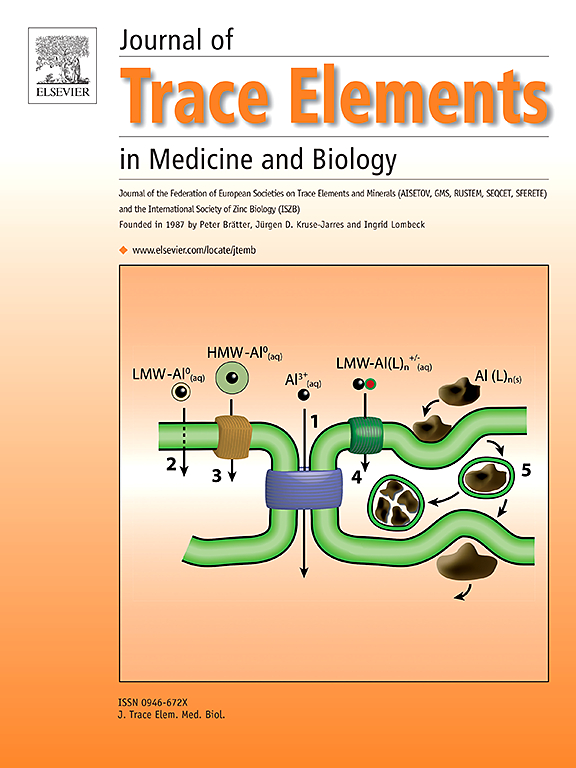Concentrations of arsenic (As), cadmium (Cd) and lead (Pb) in blood, hair and semen of stallions in Finland
IF 3.6
3区 医学
Q2 BIOCHEMISTRY & MOLECULAR BIOLOGY
Journal of Trace Elements in Medicine and Biology
Pub Date : 2025-03-14
DOI:10.1016/j.jtemb.2025.127633
引用次数: 0
Abstract
Heavy metal contamination poses significant environmental and health risks to both humans and animals. This study investigates the concentrations of arsenic (As), cadmium (Cd), and lead (Pb) in blood, hair, and semen samples collected from 16 breeding stallions in Western Finland to assess whether concentrations in hair and serum samples represent concentrations in semen. The analysis was conducted using an inductively coupled plasma mass spectrometry (ICP-MS) system. Results showed that hair samples exhibited the highest concentrations of heavy metals, particularly Pb and As, while semen showed the lowest levels. No significant correlations were found between the concentrations of heavy metals in blood and semen, or between hair and semen, indicating that blood and hair may not reliably predict metal content in semen. This study is the first to compare Pb, As, and Cd levels in hair, blood, and semen of Finnish stallions and highlights hair as a promising non-invasive biomarker of heavy metal exposure. The results underline hair's potential as a reliable long-term biomarker due to its ability to accumulate metals over time.
芬兰种马血液、毛发和精液中砷、镉和铅的含量
重金属污染对人类和动物都构成重大的环境和健康风险。本研究调查了芬兰西部16种种马的血液、毛发和精液样本中砷(As)、镉(Cd)和铅(Pb)的浓度,以评估毛发和血清样本中的浓度是否代表精液中的浓度。采用电感耦合等离子体质谱(ICP-MS)系统进行分析。结果显示,头发样本中重金属含量最高,尤其是铅和砷,而精液中重金属含量最低。血液和精液、毛发和精液中的重金属浓度之间没有发现显著的相关性,这表明血液和毛发可能不能可靠地预测精液中的重金属含量。这项研究首次比较了芬兰种马毛发、血液和精液中的铅、砷和镉水平,并强调毛发是一种很有前途的非侵入性重金属暴露生物标志物。研究结果强调了头发作为可靠的长期生物标志物的潜力,因为它能够随着时间的推移积累金属。
本文章由计算机程序翻译,如有差异,请以英文原文为准。
求助全文
约1分钟内获得全文
求助全文
来源期刊
CiteScore
6.60
自引率
2.90%
发文量
202
审稿时长
85 days
期刊介绍:
The journal provides the reader with a thorough description of theoretical and applied aspects of trace elements in medicine and biology and is devoted to the advancement of scientific knowledge about trace elements and trace element species. Trace elements play essential roles in the maintenance of physiological processes. During the last decades there has been a great deal of scientific investigation about the function and binding of trace elements. The Journal of Trace Elements in Medicine and Biology focuses on the description and dissemination of scientific results concerning the role of trace elements with respect to their mode of action in health and disease and nutritional importance. Progress in the knowledge of the biological role of trace elements depends, however, on advances in trace elements chemistry. Thus the Journal of Trace Elements in Medicine and Biology will include only those papers that base their results on proven analytical methods.
Also, we only publish those articles in which the quality assurance regarding the execution of experiments and achievement of results is guaranteed.

 求助内容:
求助内容: 应助结果提醒方式:
应助结果提醒方式:


